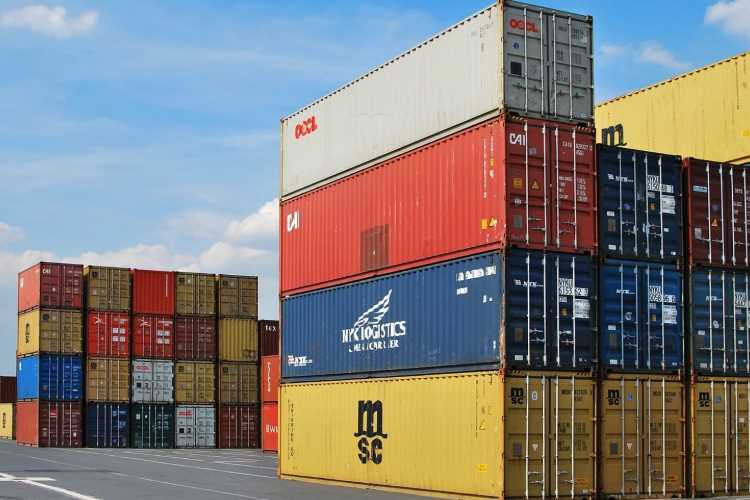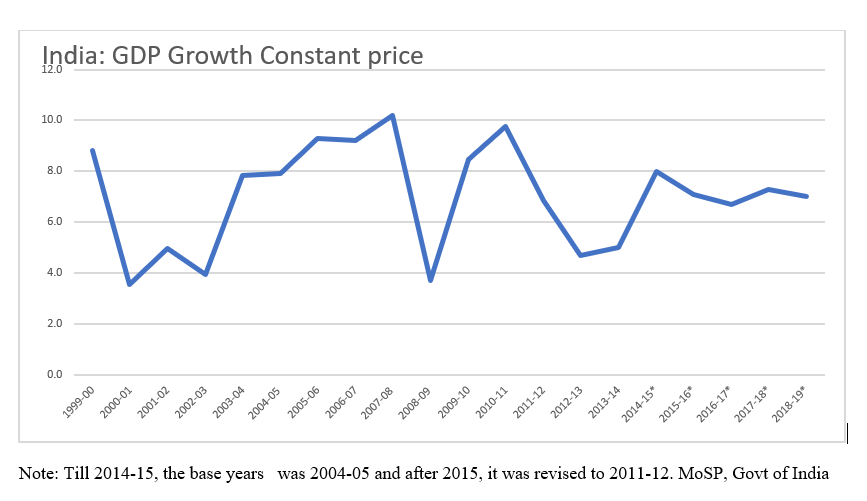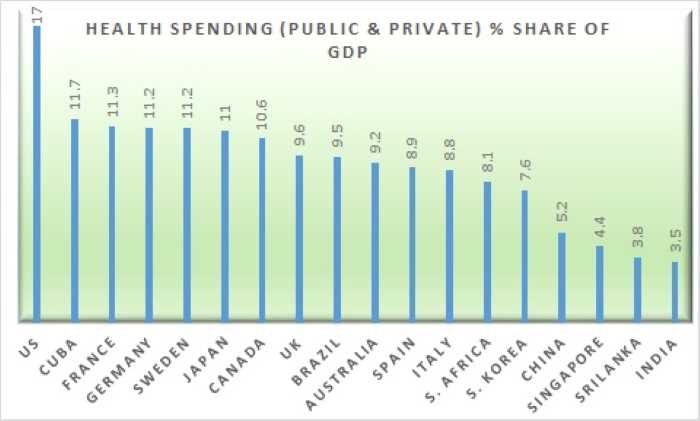
China is at the receiving end of world public opinion for its failure to fully disclose information on the new coronavirus outbreak. There are attempts by civil society in OECD countries to make China pay for its lapses. It’s too early to assess how much damage this angst can cause to China, but one thing is clear. The multinational corporations which made themselves totally dependent on China for their manufacturing needs will now look to reduce the dependence. India looks like an automatic choice, at least for us Indians, to be the second manufacturing hub that could emulate the Chinese miracle.
Covid-19 has caused the biggest disruption in world economy after World War II. Like the great war, the Covid-19 pandemic is also expected to be a game changer that will result in the economic restructuring of the world. Is India ready to play a role of a global manufacturing hub? The six-week long nation-wide lockdown has brought all sectors of the economy to their knees. The country was already facing a debilitating economic slowdown when the pandemic struck.
READ: Make PDS more inclusive, give ration cards pan-India validity

There are several factors going for India to become a global manufacturing hub and break the middle-income trap. India is a young country with an average age of 29 years. India will enjoy the demographic dividend till 2055, while China will have it only for another decade. The country has an educated middle class that has become the bulwark of a large workforce. To top it all, it is one of the few functioning democracies outside the developed world. This gives India a premium while working with the developed nations.
The Asian miracle
The post-coronavirus world economy will be different. While it may be difficult to reverse the trend towards globalisation, the disruption in global supply chains will cause a rethink among policy makers. The global merchandise trade is expected to fall by 13-32% in 2020.
A number of Asian countries such as Japan, South Korea and Taiwan had benefitted from early globalisation, while Asean countries, China and India joined them late. As a result, Asia started dominating the world trade with 40% share in exports and 30% in imports. In the new millennium, China raced ahead of other Asian nations to become the world’s largest exporting nation with a share of 13.2% ($2,499 billion), ahead of the US that had an 8.7% share. ($1,646 billion). India stands 18th in the list of largest exporters with a 1.7% share ($324 billion) share. It is also the 10th largest importer with a 2.5% ($484 billion) share. Above all, China has a trade surplus with most of its partners and is slowly pushing its economic interests across the continents in an aggressive manner, especially in the last decade.
The blame game adopted by the western nations in the wake of the Covid-19 pandemic against China indicates a possible trend in the coming days. These nations want to show China its place, and seek to change the geopolitical equations. Many commentators believe that India is the best option for western nations that are looking to shift overseas production centres out of China. They believe that the situation will present India an opportunity to move up the global economic value chain.
READ: Great lockdown: Online classes, remote working widen India’s digital divide
Learning from Chinese experience
To grab the post-Covid opportunity, India will need to prove its ability to prioritise its development goals and showcase its skill in revolutionising industrial production. It needs to put its house in order and initiate a proper assessment of its economic goals. There is a need to identify key segments to be liberalised and measures needed to address the challenges of the globalisation process. The country should bargain for time to prepare itself before adopting the process of globalisation.
Preparation is critical for a nation looking to transform itself completely. China started its liberalisation journey in 1978. Till early 1990s, it was low key activity; even though it was a top national priority. The country ensured seamless assimilation of people with the new environment while approaching goals slowly but surely. Meanwhile China trained its labour force, established key R&D institutions, regulated and de-regulated areas as per priority, prepared safety nets to protect those who are economically vulnerable and then opened the economy for a smooth transition. It avoided major disruptions through meticulous planning as it wanted to avoid misery inflicted on people during the Great Leap Forward and the Cultural Revolution.
READ: Coronavirus impact: Indian economy may prove doomsayers wrong
What India needs to do
In 2021, India will complete three decades of economic liberalisation. The globalisation and liberalisation policies were fully endorsed by both the ruling parties and opposition parties, with the exception of Left parties that do not have any clout to influence policies. If India manages to use the opportunity offered by the coronavirus outbreak, the country will enter the next level of economic development. To start the process, India needs to review its capacity to respond to the demands of a new economic system.
India’s post-liberalisation experiences show that trickle-down theory didn’t work as anticipated. The rich-poor divide became wider and the development process left out a large number of people. The Indian economy surged ahead during the financial crisis that followed the 2008 global crisis, only to face serious problems in the last one decade. In 2015, the NDA government revised the GDP assessment base year to 2011-12, which resulted in a temporary spurt in growth numbers. However, the change in methodology failed to cover the slipping GDP growth rates.
Address slowing growth
The GDP started slipping after two back-to-back big-ticket measures by the Narendra Modi government — demonetisation of high denomination currencies in 2016 and an indirect tax reform that introduced a nation-wide Goods and Services Tax in 2017. These steps were taken without much preparation and instead of triggering economic growth, they wreaked havoc in the economy. Had these measures been implemented with proper planning, results could have been different. The government needs to ensure that the economy grows at high single-digit rates to make the country attractive for investment.
Shrinking middle class
The economic liberalisation created the large Indian middle class. With the growth of the middle class, the socio-economic inequality widened, and millions of Indians faced abject poverty and deprivation. The new class with an appetite to consume non-essential goods was the main driver of the high economic growth rates witnessed by Indian economy post liberalisation. However, the last 10 years showed signs of middle-class distress, causing the economy to slow down. India needs to invest in its middle class so that the economy continues to grow. A robust domestic market is a prerequisite for attracting global investments in manufacturing.

Quality of education
The country needs to invest heavily in knowledge economy. Education is a process to prepare human resources to meet the technical and vocational needs of the market economy. India spends 3% of its GDP, or Rs 5.6 lakh crore, on education. This amount covers primary to higher education, professional education, and adult education. Up to the elementary level, around 72% of the students depend on government institutions for education. To provide quality education to its youth, India will have to spend at least 6% of its GDP as suggested by the first national policy in 1968. This will push the expenditure on education to around Rs 9.6 lakh crore in 2020-21.
Invest in public health
The country spends just 1.02% of its GDP on health, while the average for G20 nations is 6%. The per capita health spending is only Rs 1,247 in the last financial year. This amount covers community health to infrastructure development, medical care staff, medicines as well as research and development in health. According to a PWC study in 2018, the total expenditure on health was Rs 6.8 lakh crore, of which 60% is borne by private individuals.

Physical infrastructure
India needs to build a network of good roads, railway lines, ports and airports to keep the logistics cost low. It also needs to build a reliable power grid that can ensure uninterrupted power supply. According to the Economic Survey 2019-20, India needs to spend around Rs 100 lakh crore on physical infrastructure in the next five years to make India a $5 trillion economy..
To move towards a brighter future, India needs time to prepare its people to adapt to the emerging world economic environment and make efforts to upgrade skills and knowledge. The money spent on physical and social infrastructure will have a multiplier effect on the economy. Doubling of investment in health and education will not only improve the quality of the country’s human resources, but also will create a large number of employment opportunities for its educated youth.
(Dr Resmi Bhaskaran is an independent economist based in Manipal. Dr P Ravindranathan teaches at the department of geopolitics and international relations of Manipal Academy of Higher Education.)
